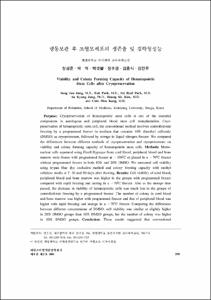냉동보관 후 조혈모세포의 생존율 및 집락형성능
- Alternative Author(s)
- Kim, Heung Sik; Kang, Chin Moo
- Journal Title
- 대한소아혈액종양학회지
- ISSN
- 1225-6978
- Issued Date
- 2001
- Abstract
- Purpose: Cryopreservation of hematopoietic stem cells is one of the essential components in autologous and peripheral blood stem cell transplantation. Cryopreservation of hematopoietic stem cell, the conventional method involves controlled-rate freezing by a programmed freezer in medium that contains 10% dimethyl sulfoxide (DMSO) as cryoprotectant, followed by storage in liquid nitrogen freezer. We compared the differences between different methods of cryopreservation and cryoprotectants on viability and colony forming capacity of hematopoietic stem cells.
Methods: Mononuclear cells separated using Ficoll-Hypaque from cord blood, peripheral blood and bone marrow were frozen with programmed freezer at -196℃ or placed in a -70℃ freezer without programmed freezer in both 10% and 20% DMSO. We measured cell viability using trypan blue dye exclusion method and colony forming capacity with methyl cellulose media at 7, 30 and 90 days after thawing.
Results: Cell viability of cord blood, peripheral blood and bone marrow was higher in the groups with programmed freezer compared with rapid freezing and storing in a -70℃ freezer. Also as the storage time passed, the decrease in viability of hematopoietic cells was much less in the groups of controlled-rate freezing by a programmed freezer. The number of colony in cord blood and bone marrow was higher with programmed freezer and that of peripheral blood was higher with rapid freezing and storage in a -70℃ freezer. Comparing the differences between different concentraions of DMSO, cell viability was similar or slightly higher in 20% DMSO groups than 10% DMSO groups, but the number of colony was higher in 10% DMSO groups.
Conclusion: These results suggested that conventional cryopreservation method using programmed freezer with 10% DMSO was more effective in the cryopreservation of hematopoietic stem cells.
목적: 조혈모세포의 냉동은 자가 이식에서 또는 제대혈 은행에서 필수 불가결한 과정이다. 이식 후 생착은 냉동한 조혈모세포의 수와 생존율, 그리고 기능이 중요한 관건이다. 본 연구는 조혈모세포의 종류에 따라 그리고 이용한 냉동매체 및 냉동방법에 따라 냉동보관 후 일정기간이 지난 후 해동하여 세포 생존율과 세포의 기능을 보기 위하여 조혈모세포 집락형성을 비교해 보고자 하였다.
방법: 골수, 말초혈액 및 제대혈의 단핵구를 수집하여 10% 또는 20% DMSO와 자가 혈청을 섞어 프로그램 냉동기를 이용하여 액체질소에 보관하거나 바로 -70℃ 냉동고에 넣어 냉동보관하였다가 냉동 7일, 30일, 90일에 해동하여 세포 생존율과 집락형성능을 비교해 보았다.
결과: 프로그램 냉동기 없이 바로 -70℃ 냉동기에 보관한 경우의 세포 생존율은 20% DMSO를 사용한 경우 제 7일, 30일, 90일의 새포 생존율은 제대혈에서는 81.8%, 82.0%, 75.8%, 골수에서는 85.3%, 81.1%, 72.3%이었고 말초혈액에서는 88.8%, 85.9%, 83.1%이었으며, 10% DMSO를 사용한 경우에는 제대혈은 76.0%, 68.4%, 66.4%, 골수에서는 78.2%, 74.6%, 69.3%, 말초혈액에서는 89.8%, 80.6%, 80.6%이었다.
프로그램 냉동기 사용 후 -196℃에서 냉동보관한 경우의 세포 생존율은 20% DMSO를 사용한 경우 제 7일, 30일, 90일의 세포 생존율은 제대혈에서는 87.0%, 86.6%, 86.5%, 골수에서는 80.0%, 84.4%, 84.4%, 말초혈액에서는 90.0%, 90.0%, 91.1%이었으며, 10% DMSO를 사용한 경우에는 제대혈은 83.9%, 84.3%, 84.4%, 골수에서는 80.1%, 83.4%, 83.7%, 말초혈액에서는 87.2%, 84.5%, 80.5%로 모든 경우에서 -70℃로 냉동보관하는 것보다 프로그램 냉동기를 사용하는 것이 세포 생존율이 높게 나타났다.
집락형성능은 제대혈, 골수, 말초혈액 모두에서 전반적으로 10% DMSO를 사용한 경우가 집락수가 더 많았으며, 제대혈과 골수는 프로그램 냉동기로 냉동보관한 것이, 말초혈액은 -70℃에 바로 넣어 냉동보관하는 것이 집락형성능이 더 높게 나타났다.
결론: 제대혈, 골수 및 말초혈액을 프로그램 냉동기와 10% DMSO를 이용하여 냉동보관하였을 때 세포 생존율과 집락형성능이 우수하였고 냉동시간 경과에 따른 세포 생존율의 감소도 적었다. 이러한 결과로 볼 때 조혈모세포의 냉동보관법으로는 10% DMSO를 냉매로 하여 프로그램 냉동기에서 냉동시키는 것이 가장 효과적인 것으로 사료된다.
- Alternative Title
- Viability and Colony Forming Capacity of Hematopoietic Stem Cells after Cryopreservation
- Department
- Dept. of Pediatrics (소아청소년학)
- Publisher
- School of Medicine
- Citation
- 장성준 et al. (2001). 냉동보관 후 조혈모세포의 생존율 및 집락형성능. 대한소아혈액종양학회지, 8(2), 298–304.
- Type
- Article
- ISSN
- 1225-6978
- Appears in Collections:
- 1. School of Medicine (의과대학) > Dept. of Pediatrics (소아청소년학)
- 파일 목록
-
-
Download
 oak-bbb-1959.pdf
기타 데이터 / 2.37 MB / Adobe PDF
oak-bbb-1959.pdf
기타 데이터 / 2.37 MB / Adobe PDF
-
Items in Repository are protected by copyright, with all rights reserved, unless otherwise indicated.